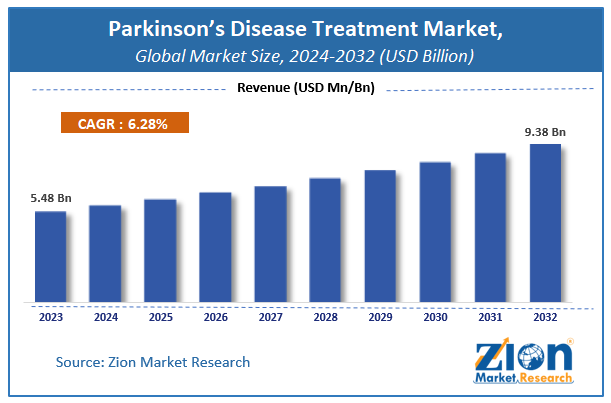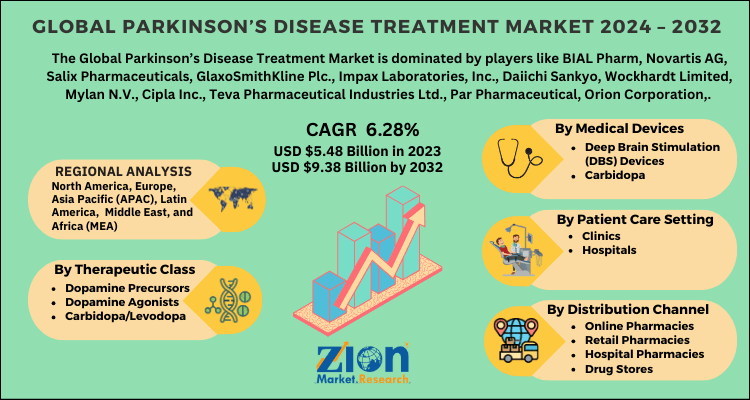Parkinson's Disease Treatment Market Demand, Size, Share & Forecast 2032

Parkinson’s Disease Treatment Market By Therapeutic Class (Dopamine Precursors, Monoamine Oxidase B Inhibitors, Catechol-O-Methyl Transferase Inhibitors, Carbidopa/Levodopa, Dopamine Agonists, And Other Therapeutic Classes), By Medical Devices (Deep Brain Stimulation Devices And Carbidopa/Levodopa Enteral Suspension Delivery Devices), By Patient Care Setting (Clinics And Hospitals), By Distribution Channel (Online Pharmacies, Retail Pharmacies, Drug Stores, And Hospital Pharmacies), And By Region - Global Industry Perspective, Comprehensive Analysis, And Forecast, 2024 - 2032-
| Market Size in 2023 | Market Forecast in 2032 | CAGR (in %) | Base Year |
|---|---|---|---|
| USD 5.48 Billion | USD 9.38 Billion | 6.28% | 2023 |
Parkinson’s Disease Treatment Market: Industry Perspective
The global parkinson’s disease treatment market size was worth around USD 5.48 billion in 2023 and is predicted to grow to around USD 9.38 billion by 2032 with a compound annual growth rate (CAGR) of roughly 6.28% between 2024 and 2032.
The report offers a valuation and analysis of the Parkinson’s disease Treatment market on a global and regional level. The study comprehensively assesses the industry competition, limitations, sales estimates, avenues, current & emerging trends, and industry-validated market data. The report offers historical data from 2018 to 2022 along with a forecast from 2024 to 2032 based on value (USD Billion).
Parkinson’s Disease Treatment Market Overview
Parkinson's is a chronic neurodegenerative disorder that affects body movements and results in tremors in hands, stiffness in movements of body parts & muscles, bradykinesia, and postural instability. Other symptoms of the disease include depression, dysphagia, emotional changes, constipation, urine problems, dysarthria, disturbed sleep, and skin problems. The disease has a notable impact on mobility as well as muscle control of the patients. Furthermore, the disease is influenced by both motor as well as non-motor characteristics. For instance, motor symptoms of the disease are attributed to the loss of striatal dopaminergic neurons and non-motor symptoms of the disorder support the loss of neurons in non-dopaminergic areas of the nervous system.
According to NCBI, at present, there are no disease-altering therapies for the disease. However, medical management makes use of dopaminergic medicines and deep brain stimulation to treat patients having Parkinson's disease. Reportedly, levodopa therapy is the most commonly used for treating Parkinson's disorder in its early stages and can help reduce tremor, bradykinesia, and muscle rigidity to a large extent in patients. Moreover, levodopa is combined with a dopa-decarboxylase inhibitor to restrict side effects like nausea. For the record, dopamine agonists like rotigotine or ropinirole are also popular medicines used for treating Parkinson's disease. In addition to this, monoamine oxidase B inhibitors like selegiline and rasagiline as well as catecho-o-methyltransferase inhibitors like entacapone are utilized for reducing the metabolism of dopamine. These therapies can restore dopaminergic activities in the striatum along with bringing enhancements in motor features of Parkinson's disorder.
Parkinson’s Disease Treatment Market: Growth Dynamics
Massive utilization of L-Dopa, a symptomatic dopamine replacement treatment and nigrostriatal system will boost the market trends. In addition to this, the shifting of research activities from symptomatic treatment to Parkinson's disorder modifying treatment will create lucrative growth avenues for the Parkinson’s disease treatment industry over the forthcoming years. Large-scale research and clinical trials are under way for bringing a revolution in symptomatic treatment of Parkinson’s disease and this can embellish the business growth. Apart from this, vital breakthroughs in the development and clinical testing of drugs for providing modification in Parkinson’s disease are projected to contribute substantially towards the growth of the Parkinson’s disease treatment industry over the years to come. Reportedly, cell-based approaches and viral gene-delivery approaches are also the best available alternatives for treating Parkinson's Disease and this will help the market reach new horizons of growth within the next couple of years.
Furthermore, ongoing genetic & neuropathological research is predicted to provide new insights into the understanding of Parkinson's disorder and this will enhance the market earnings in the coming decade. Citing an instance, in 1997, a new gene mutation for alpha-synuclein protein causing autosomal dominant Parkinson's disorder was discovered. Additionally, the use of non-dopaminergic drugs like amantadine and anticholinergic has proved to offer symptomatic relief in the early stages of Parkinson's disease treatment. Anticholinergic drugs like benztropine and trihexphenidyl are used in young patients impacted due to tremors and these drugs are used along with levodopa.
Additionally, the Braak staging hypothesis that Parkinson's disorder begins in either the olfactory bulb or the gastrointestinal system has paved the way continuum of researchers in the domain of Parkinson's disease treatment, thereby driving the growth of the market in the coming years. Furthermore, the use of adjunctive therapy and anti-glutamatergic medicines for treating Parkinson's disease will proliferate the expansion of the Parkinson’s disease treatment market over the forthcoming years.
Parkinson’s Disease Treatment Market: Segment Analysis
The global Parkinson’s disease treatment market is segmented based on therapeutic class, medical devices, patient care setting, distribution channel, and region.
By therapeutic class, the market is classified into dopamine precursors, monoamine oxidase B inhibitors (MAO-B inhibitors), catechol-O-methyl transferase (COMT) inhibitors, carbidopa/levodopa, dopamine agonists (non-ergoline), and other therapeutic classes.
In terms of medical devices, the market is segmented into deep brain stimulation (DBS) devices and carbidopa/levodopa enteral suspension (Duopa) delivery devices.
Based on the patient care setting, the market is divided into clinics and hospitals. Based on the distribution channel, the market is divided into online pharmacies, retail pharmacies, drug stores, and hospital pharmacies.
Parkinson’s Disease Treatment Market: Report Scope
| Report Attributes | Report Details |
|---|---|
| Report Name | Parkinson’s Disease Treatment Market |
| Market Size in 2023 | USD 5.48 Billion |
| Market Forecast in 2032 | USD 9.38 Billion |
| Growth Rate | CAGR of 6.28% |
| Number of Pages | 245 |
| Key Companies Covered | BIAL Pharm, Novartis AG, Salix Pharmaceuticals, GlaxoSmithKline Plc., Impax Laboratories, Inc., Daiichi Sankyo, Wockhardt Limited, Mylan N.V., Cipla Inc., Teva Pharmaceutical Industries Ltd., Par Pharmaceutical, Orion Corporation, and Apotex Inc., and others. |
| Segments Covered | By Therapeutic Class, By Medical Devices, By Patient Care Setting, By Distribution Channel, and By Region |
| Regions Covered | North America, Europe, Asia Pacific (APAC), Latin America, The Middle East and Africa (MEA) |
| Base Year | 2023 |
| Historical Year | 2018 to 2022 |
| Forecast Year | 2024 - 2032 |
| Customization Scope | Avail customized purchase options to meet your exact research needs. Request For Customization |
Parkinson’s Disease Treatment Market: Regional Analysis
- Asia Pacific Market To Record Highest Growth Rate Over 2024-2032
The growth of the industry in the sub-continent over the estimated timespan is owing to favorable government policies and a surge in research activities about the treatment of Parkinson's disease in countries like India, Japan, and China. In addition to this, huge sales of generic medicines and a surge in the aging population prone to Parkinson's disorder will further prop up the growth of the Parkinson’s disease market in the Asia Pacific zone.
Parkinson’s Disease Treatment Market: Competitive Analysis
The global parkinson’s disease treatment market is dominated by players like:
- BIAL Pharm
- Novartis AG
- Salix Pharmaceuticals
- GlaxoSmithKline Plc.
- Impax Laboratories, Inc.
- Daiichi Sankyo
- Wockhardt Limited
- Mylan N.V.
- Cipla Inc.
- Teva Pharmaceutical Industries Ltd.
- Par Pharmaceutical
- Orion Corporation
- Apotex Inc.
The global Parkinson’s disease treatment market is segmented as follows:
By Therapeutic Class
- Dopamine Precursors
- Monoamine Oxidase B Inhibitors (MAO-B Inhibitors)
- Catechol-O-methyl transferase (COMT) Inhibitors
- Dopamine Agonists (Non-ergoline)
- Carbidopa/Levodopa
- Other Therapeutic Classes
By Medical Devices
- Deep Brain Stimulation (DBS) Devices
- Carbidopa/Levodopa Enteral Suspension (DUOPA) Delivery Devices
By Patient Care Setting
- Clinics
- Hospitals
By Distribution Channel
- Online Pharmacies
- Retail Pharmacies
- Hospital Pharmacies
- Drug Stores
By Region
- North America
- The U.S.
- Canada
- Europe
- France
- The UK
- Spain
- Germany
- Italy
- Rest of Europe
- Asia Pacific
- China
- Japan
- India
- South Korea
- Southeast Asia
- Rest of Asia Pacific
- Latin America
- Brazil
- Mexico
- Rest of Latin America
- Middle East & Africa
- GCC
- South Africa
- Rest of Middle East & Africa
Table Of Content
Methodology
FrequentlyAsked Questions
Parkinson's disease is a progressive neurological disorder. Parkinson's disease has no cure, but treatments can manage symptoms significantly. These include medications, surgery (in some cases), and physical/occupational therapy.
According to a study, the global parkinson’s disease treatment market size was worth around USD 5.48 billion in 2023 and is expected to reach USD 9.38 billion by 2032.
The global parkinson’s disease treatment market is expected to grow at a CAGR of 6.28% during the forecast period.
Asia Pacific is expected to dominate the parkinson’s disease treatment market over the forecast period.
Leading players in the global parkinson’s disease treatment market include BIAL Pharm, Novartis AG, Salix Pharmaceuticals, GlaxoSmithKline Plc., Impax Laboratories, Inc., Daiichi Sankyo, Wockhardt Limited, Mylan N.V., Cipla Inc., Teva Pharmaceutical Industries Ltd., Par Pharmaceutical, Orion Corporation, and Apotex Inc., among others.
The parkinson’s disease treatment market report covers the geographical market along with a comprehensive competitive landscape analysis. It also includes cash flow analysis, profit ratio analysis, market basket analysis, market attractiveness analysis, sentiment analysis, PESTLE analysis, trend analysis, SWOT analysis, trade area analysis, demand & supply analysis, Porter’s five forces analysis, and value chain analysis.
RelatedNews
HappyClients
Zion Market Research
Tel: +1 (302) 444-0166
USA/Canada Toll Free No.+1 (855) 465-4651
3rd Floor,
Mrunal Paradise, Opp Maharaja Hotel,
Pimple Gurav, Pune 411061,
Maharashtra, India
Phone No +91 7768 006 007, +91 7768 006 008
US OFFICE NO +1 (302) 444-0166
US/CAN TOLL FREE +1 (855) 465-4651
Email: sales@zionmarketresearch.com
We have secured system to process your transaction.
Our support available to help you 24 hours a day, five days a week.
Monday - Friday: 9AM - 6PM
Saturday - Sunday: Closed






